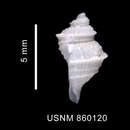en
names in breadcrumbs


"Falsitromina powelli n.sp. (Fig. 286)
MATERIAL EXAMINED: Eltanin Stns 161, 339, 557.
DISTRIBUTION: Known only from off the Falkland Islands and off Tierra del Fuego in 512-878 m.
DESCRIPTION: Shell small, white, biconic, strongly carinate. Spire relatively short, 0.55 times the height of the aperture. Protoconch of two dome-shaped whorls, the apex smooth but developing microscopic spiral threads crossed over the last half whorl by dense, fine, closely spaced axial threads. Spire whorls carinated about the middle by a strong keel with a minor spiral cord on the ramp and a second minor cord just emerging from the abapical suture. The strong keel continues across the last whorl rendering it strongly carinate. Two minor spiral cords are developed on the ramp, a further five cords diminishing in strength across the rest of the last whorl, and eight further spiral cords more or less equal in strength across the canal. All the spiral cords are crossed by crisp narrow axial ribs, more numerous on the penultimate whorl, forming minute nodules where they cross the spiral cords and continuing across the base and the canal. Last whorl gradually constricted to form a prominent canal. Aperture narrowly ovate, outer lip thin, strongly angled by the major carina and to a lesser degree by the weaker spiral cords, drawn out abapically into an open canal. Parietal lip spread as a glaze across last whorl. Columella vertical, straight and smooth.
DIMENSIONS: height 7.0 mm, diameter 4.7 mm (holotype).
HOLOTYPE: from Eltanin Stn 557, in National Museum of Natural History (USNM 860120).
PARATYPES: from Eltanin Stns 161 (one, USNM 860122), 339 (one, USNM 860123) and 557 (2, USNM 860121) in National Museum of Natural History and from Stn 557 (2, MF.56612) in National Museum of New Zealand.
REMARKS: The shape and rather peculiar sculpture on the protoconch ally F. powelli to F. bella, F. fenestrata and F. simplex. The range of shell outline and sculpture within these three species is quite wide, and F. powelli adds a further dimension. The strongly carinate shell and the elongate last whorl and canal render F. powelli distinct from all previously named species."
(Dell, 1990: 176-177)